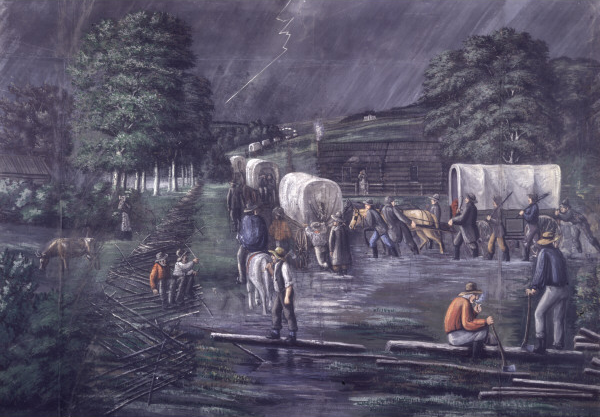 |
| “Zion’s Camp” by C.C. Christensen |
I teach online Seminary for our Stake, for those kids who live too far away to attend early morning Seminary. This year we are studying the Doctrine and Covenants and last week we studied the sections 103-105, that deal with the history of Zion’s Camp. Zion’s Camp was an army organized by the prophet Joseph Smith to march from Kirtland, Ohio to Independence, Missouri to assist the Saints that had been attacked there and to reclaim the land that had been confiscated by mobs. The army was not large, around 200 men, and they endured many trials on their 900 mile trek, including lack of fresh water, food, persecution, and cholera.
In the end divisions within the camp prompted a revelation from the Lord that told them that they would not be able to redeem Zion. Many of them returned to Ohio without the opportunity to fight for their lands. Despite the disappointment the journey was a powerful spiritual experience for many of the participants. As author Andrea G. Radke wrote:
“While considered a failure in its ultimate goal of reclaiming lost lands and relieving the heavy persecutions in Missouri Zion’s Camp has been seen as a historical turning point for The Church of Jesus Christ of Latter-day Saints, from the members of Zion’s Camp Joseph Smith drew a majority of the Quorum of the Twelve Apostles and the whole of the First Quorum of the Seventy. The hardships of the 1834 Missouri expedition provided important enduring legacies uniting its members in a stronger loyalty to Joseph Smith and other leaders, solidifying the participants dedication to the church’s cause, and schooling young leaders in the organizational skills necessary to move masses of people.” (Source)
I have often thought of the women and children who were left behind in Ohio as their husband’s and son’s (and most of the church leadership) went with Zion’s Camp, and how they must have struggled to hold things together back in Kirtland. Yet I was surprised as I studied the history of Zion’s Camp this time to learn that there were at least 12 women and 7 children who also traveled with the camp.
I think we forget that throughout history women have often traveled with armies and military campaigns, often in the rear of the army as cooks, laundresses, and nurses. This is true of just about all wars throughout history. Remembering this fact can help you learn to “see” the women in the wars of the Bible and the Book of Mormon. There were almost always women who traveled with armies and military campaigns, but you rarely ever hear about them.
Yet, the women of Zion’s Camp are unique in that while they probably did assist with the cooking and the laundry it doesn’t seem to be their main reason for being included. In fact, Joseph Holbrook, who traveled with his wife and two small daughters, wrote about an interesting experience that the women of Zion’s Camp had shortly before the camp made its way into Missouri.
The camp was getting ready to move into the more dangerous part of Missouri and Joseph Smith asked the men to arrange cabins for the women and children to stay in while the men went on ahead. Joseph Holbrook recorded,
“When
we came to the Salt River Creek in Missouri, about 50 miles west
of Louisiana, we tarried for some three or four days to wash,
etc. Then Brother Joseph Smith counselled those that had
families to get houses for them, and for the man to go forward
with the camp. So I provided a house for my family as decided
and was about to leave my family as was the rest of the brethren
who had wives with them.Then Brother Joseph Smith said, if the
sisters were willing to undergo a siege with the camp they could
all go along with it, whereupon they said they could and said
they liked Brother Joseph much better than before for the
privilege he gave them of continuing with the camp.At this
place as at many others on the road, we had many of the brethren
who united with the camp. We were often met by strangers who
would interrogate us as to where we were going and what our
business was, etc. Then they would often threaten us if we went
further, etc. and said that we had a standard raised with
“death” on one side and “blood” on the other until we were
forced to raise a standard with “peace” on both sides which they
could not hardly believe when they saw it for they were so
prejudiced in their feelings they could not hardly believe their
better senses. And thus we continued our journey.” (Source)
We don’t know why Joseph Smith changed his mind and decided that “if the sister were willing” they could continue on with the army. Maybe the sisters felt afraid or at upset at being left behind by themselves or maybe he felt that the women had earned the right, by facing the same trials as the men, to decide for themselves if they would go or not. It impresses me that these women chose to go with the camp. We have to remember that they were facing some major persecution in Missouri and they fully expected to be confronted with physical violence. These women showed real courage in being willing to march into battle (even with little children in tow) and to follow the prophet where ever he would lead them.
Often when we share the story of Zion’s Camp we focus on how it was a defining spiritual experience for many of the church’s future leaders, and I think that same idea can be applied to the women who also traveled with the camp. It is significant that all of the women and children who traveled with the camp remained faithful to the church, in addition to facing the extreme persecutions of Missouri, the trials of Nauvoo, and making the trek across the wilderness to Salt Lake City, Utah. In fact, it is interesting to note that the participants of Zion’s camp walked 900 miles to Missouri, and many of them walked 900 miles back to Ohio. Later most of them would walk the 1,032 miles from Winter Quarters to the Salt Lake Valley, which must have seemed like a similar trip to the one they had made before!
It was powerful for me to study about each one of these women and to
imagine what her life must have been like and what her motivation must
have been for wanting to travel with Zion’s Camp. These women’s experiences and lives were different, but they were tied together by a common thread of faith and their examples are important for us today.
I hope that you will enjoy learning about these women as much as I did, and that next time you talk about Zion’s Camp you can remember to add them into your conversation. If you are interested in learning even more there is a wonderful article written by Andrea G Radke entitled “We Also Marched: The Women and Children of Zion’s Camp, 1834” that gives an in-depth look at each many of these women’s lives and their experiences.
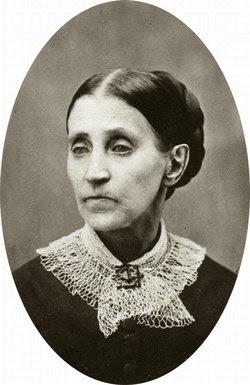 |
| Charlotte Alvord Curtis |
Charlotte Alvord
Charolotte Alvord was about 18- years-old when she traveled with Zion’s Camp, and since there is no other person with the last name of Alvord recorded as traveling with Zion’s Camp it can be assumed that she traveled independently. It intrigues me to think of what her motivation was for going with Zion’s Camp. Perhaps she was traveling with friends, relatives or maybe intended to meet up with family or associates who were already in Missouri. Or there is always the possibility that she, like some of the young men who went, wanted to do all she could to redeem Zion.
Her story is also fun because it involves romance. While she traveled with Zion’s Camp she met a young man named Lyman Curtis, who was traveling with his brother Mecham and sister-in law Sophronia. Lyman and Charlotte fell in love and were married not long after Zion’s Camp reached Missouri. She and Lyman later went on to have 11 children and both traveled with the Saints to Nauvoo and later to Salt Lake City.
Sophronia Curtis
Little is know about her expect that she was married to Mecham Curtis, which means that Charlotte Alvord (mentioned above) would have become her sister-in law. Many of those traveling to Missouri with their families intended to stay in Missouri and join with the saints there. It makes sense to me that the reason she and her husband were both traveling with Zion’s Camp was that they intended to stay in Missouri permanently.
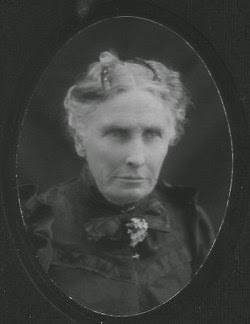 |
| Mary Chidester’s daughter, Eunice Chidester Harmon, who traveled with Zion’s Camp at the age of 1 |
Mary Parker Chidester
Mary traveled with her husband John M. Chidester and their two young children, John P. Chidester (age 2) and Eunice Chidester (age 1). I assume that like some of the other families who traveled with Zion’s Camp that they were intending to settle in Missouri. It is impressive to me to think about Mary traveling such a long distance with two very small children. Joseph Smith had a hard time finding men willing to volunteer to go with Zion’s Camp. The Lord initially told Joseph that he needed 500 men in order to redeem Zion, but said that if he couldn’t find enough then they should only go if they had 100 men willing to march (D&C 103:30-34). I think it says something about they type of faith and testimony that Mary and her husband John had that they volunteered to go with Zion’s camp, and bring along their children, at a time when many of the grown men of the church were unwilling to go. She certainly demonstrated incredible faith and courage that not only gave her power to travel with Zion’s Camp, but also to remain faithful throughout the struggles in Missouri and Nauvoo. Eventually Mary and her family would travel West and settled in Southern Utah.
Diana Drake
There is not much known
about her, but there was no other “Drake” listed in the participants of
Zion’s Camp indicating that she may have traveled without her
family. Radke wrote this about her,
“The
historical record gives the name of a Diantha Drake born December 15,
1815 in Vermont of Daniel and Patience Perkins Drake. If this person
accompanied Zion’s Camp she would have been eighteen- years-old and most
likely unmarried. No men with the surname Drake appear on any Zion’s
camp lists. Diana Drake probably remained loyal to the church and
traveled to the west with the Saints. She is one of three women who
attended the Zion’s Camp reunion on October 9, 1869.” (Source)
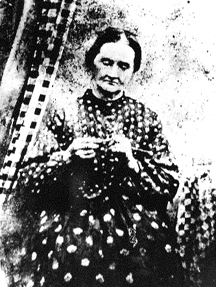 |
| Ada Clements |
Ada Clements
Ada Clements and her husband Albert Clements joined the church in Palmyra, New York and moved to Kirtland, Ohio in about 1833. They only lived there about a year before they traveled with Zion’s Camp in May of 1834. Ada and Albert had five living children at the time of their departure, Alvin (about 12), Lucy (about 9) , Paul (about 5), James (about 2), and Eliza who had been born in Ohio and was about 2 months old. None of the children are listed as traveling with the camp and so it might be that they were left in the care of others while their parents traveled. Personally I find it hard to believe that she would have left behind a two- month-old daughter! There is always the possibility the children did travel with the camp as well but were undocumented. Either way, after Zion’s Camp the Clements settled in Missouri, as the next two of their children were born in Missouri in 1836 and 1839.
Eventually the Clements would travel on with the Saints to Nauvoo. Yet at the death of the prophet Joseph Smith a rift sprang up between Ada and Albert over who should be lead the church. One of their descendants recorded,
“Albert was not home at the time but away from home working for church interests and to support his family when he heard the terrible news about the prophet, he immediately started for home. On the way his horse took sick and he stopped at a store to obtain medicine. Here he met his friend Sidney Rigdon who had converted him. Sidney told Albert he was hurrying back to Nauvoo to be with the Saints during the time of sorrow and to take his place as their leader. Albert was happy to learn of Mr. Rigdon’s decision.
When Albert came home August 15, 1844 his wife and children were pleased to have him home again. Ada told him how happy she would have been if he had been there a week ago this morning to the meeting that was held in the grove when Brigham Young was chosen as their leader. She described how Brigham Young had taken on the appearance and voice of the prophet Joseph Smith. Albert could not accept Brigham Young as the new leader and continued to follow Sidney Rigdon. When the Saints began preparations for the westward journey, Albert asked his wife if she were going to leave him as he refused to follow Brigham. Ada was sure in her heart that she must go with the Saints and share their fate. She begged her husband to come with her saying she would never cease to love him, and would always pray for him to see the truth… Ada cast her lot with the Saints and was among the earliest Saints to leave Nauvoo for Iowa and eventually Winter Quarters. Albert helped all he could to provide food and other necessities to make his family comfortable and then bade them goodbye in great sorrow. Ada stayed in Winter Quarters almost 5 years before she could come West with the Saints. Two of her daughters Eliza and Elizabeth came to Utah earlier in October 1847 with Capt. Jedediah Grant’s company. She crossed the plains in the Warren Snow company arriving in Salt Lake, Oct 9 1852. Her 9 year old son Nephi drove the ox team most of the way across the plains.” (Source)
Later, both Ada and Albert would remarry and be widowed. Later, at the age of 71, Albert finally came West and he and Ada were remarried in 1872.
Mary Minerva Snow Gates
The best part of doing this whole post was that I realized that I am related to Mary Minerva Snow Gates! She traveled with her husband Jacob Gates and was the daughter of Levi Snow (who I am related to) and a relative of the future prophet, Lorenzo Snow. It appears that she and Jacob joined with Zion’s Camp not long after they had joined the church. In my family history records it says this about her:
“It seems likely that Mary Snow attended the St. Johnsbury Female Academy, established in 1824 by an act of the General Assembly of Vermont. She had a good education “and knew her astronomy like most people know their alphabet.” She married Jacob Gates in March 1833 and she and Jacob were baptized members of the Church by Orson Pratt, June 18, 1833 as were Gardner Snow, Willard Snow, and Lucina Snow. After they left St. Johnsbury, they had many experiences in Missouri. Some years later, Mary and Jacob Gates arrived in the Salt Lake Valley, along with Willard. Erastus told of his sister Mary’s down-to-earth outlook. Mary, idealistic, spiritual and intellectual, was also practical and sensible… In St. George, where Mary and Jacob lived much of their lives she was always regarded as a lady of great learning, erudition, and wisdom.”
Another little tidbit I found about her comes from Susa Young Gates’ description of Emmeline B. Wells’s (later a General Relief Society President) trip to Nauvoo and her first meeting with the prophet Joseph Smith. She wrote,
“Among her [Emmeline’s] companions en route from Albany were returning missionaries who knew the Prophet Joseph Smith, and the girl listened eagerly to the conversations and descriptions given of him by his devoted followers: especially was she delighted at the promise made her by Mrs. Mary Snow Gates to introduce her to the prophet.” (From “History of the Young Ladies Mutual Association of the Churhc of Jesus Christ of Latter-day Saints, November 1869- June 1910” by Susa Young Gates.)
Jacob Gates served a mission to
the New England States from June 1843 to May 1844. It appears from Susa Young Gates story that Mary either went with him on his mission (his health had been feeble) or she had met him upstream on his return home. It is exciting to get more glimpses into these early pioneer women’s lives, and how interconnected they all would have been!
Both Mary and Jacob Gates remained faithful through all the struggles of Missouri and
Illinois and traveled to Salt Lake City with the Saints. Her husband
Jacob Gates later served a mission to England and served in the
presidency of the Seventy for many years. Apparently Mary Snow Gates never had children and struggled in her later years with mental health issues. Radke wrote,
“Mary’s life included much sadness and difficulty plagued by continual marital problems Jacob and Mary separated and she settled into a house in St George, Utah. In a letter to Mary’s brother Erastus Jacob related Mary’s history of personal problems:
“I am aware that she has long since been an unwelcom visiter to her brothers and all of your family & everybody els & it is a miserable condition for any one to be in. You know she has been insane one half of her half of & the spirit she has cherised has produced but little comfort to her self or me but with all her faults I neve harber biterness in my heart toard her for I believe her naturley to be a good woman.”
Childlessness and anguish over her husband s polygamous marriages caused Mary great mental anguish in her later life, but the earlier hardships of Zion’s Camp and life in Missouri may have contributed to her emotional difficulties. Jacob recognized the severity of Mary’s experiences in Missouri as, “She was left alone in the midst of enemies.” (Source)
Latter-day Saint women suffered some real atrocities under the mobs in Missouri and it breaks my heart to think that Mary may have suffered
long-term because of what she went through there.
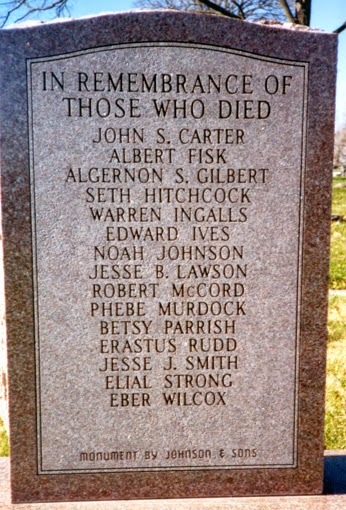 |
| Monument that commemorates those who died as a result of the outbreak of cholera among Zion’s Camp. |
Betsy Parish
Betsy Parish, who traveled with her husband Warren Parish, was the only woman to die during Zion’s Camp. She was among the thirteen camp members to die from the cholera outbreak in the camp. Many others, including Nancy and Eunice Holbrook, also contracted cholera but recovered. Cholera is a high contagious disease that cause violent spams and uncontrollable vomiting. Today we know that it is passed through drinking contaminated water, but it is still a deadly disease that can be hard to control. Many among the camp felt that the cholera outbreak was a punishment from God for the murmuring and discord that had sprung up among the members.
You will notice on the picture of the monument (above) that above Besty’s name is the name Phebe Murdock. Phebe was the daughter of John Murdock, an older sister to the two Murdock twins adopted by Emma and Joseph Smith. Author Kenneth R. Mays wrote this about her death.
“On June 24, members of the Camp marched to the home of A. Sidney Gilbert, located a few miles east of Liberty, Missouri, and camped on the on the bank of Rush Creek, in George Burkett’s field.” That same day, many began feeling ill, being stricken with cholera, including Joseph and Hyrum Smith. John Carter, a former Baptist minister who had preached with Joseph Smith in Jacksonville, Illinois, was the first to die as a result of disease. Thirteen camp members died at Rush Creek. Two other Latter-day Saints, including A. Sidney Gilbert and young Phebe Murdock, six year-old daughter of John and Julia Clapp Murdock, also contracted cholera and subsequently died.” (Source)
Sarah Ripley
Sarah would have been about thirty-two years-old and traveled with her husband Alanson Ripley. She
is mentioned as “Mrs. Ripley” in Heber C. Kimball’s diary. He recorded,
“My first attempt at washing my clothes took place at Salt
River. My shirts being extremely dirty, I put them into a kettle of
water and boiled them for about two hours having observed that women who
washed boiled their clothes, and I supposed by so doing they boiled out
the dirt. I then took them and washed them endeavoring to imitate a
woman washing as near as I could. I rubbed the clothes with my knuckles
instead of the palm of my hand and rubbed the skin off so that my hands
were very sore for several days. My attempts were vain in trying to get
the dirt out… and finally gave it up and wrung them and hung them out
to dry. Having no flat irons to iron them I took them to Sisters
Hollbrook and Ripley to get them ironed when they saw them they said I
had not washed my clothes. I told them I had done my best, and although I
had boiled them two hours before washing, and had washed them so
faithfully that I had taken the skin off my knuckles, still I had not
been successful in getting the dirt out. They laughed heartily and
informed me that by boiling before washing I had boiled the dirt into
them.” (Source)
Sarah and Alanson both traveled to Nauvoo and were apparently good
friends of the Prophet Joseph Smith. In her autobiography Prescindia
Lathrop Huntington remembered that,
“In the month of February, 1839, my father, with Heber C.
Kimball, and Alanson Ripley, came and stayed overnight with us,
on their way to visit the prophet and brethren in Liberty Jail.
I was invited to go with them. When we arrived at the jail we
found a heavy guard outside and inside the door. We were
watched very closely, lest we should leave tools to help the
prisoners escape. I took dinner with the brethren in prison; they were much
pleased to see the faces of true friends; but I cannot describe
my feelings on seeing that man of God there confined in such a
trying time for the saints, when his counsel was so much needed.
And we were obliged to leave them in that horrid prison,
surrounded by a wicked mob.” (Source)
Alanson served as the Bishop in the Iowa Territory from 1839- 1841.
But it appears that he was removed from his office for poor behavior.
William Clayton recorded in his journal on April 7, 1841 that at a
conference of the church, “Alanson Ripley had his Bishopric taken from him for frequently being drunk and not fit for business.” (Source)
Despite this the Ripleys appear to have remained faithful because they
both received their endowment in the Nauvoo temple in 1846.
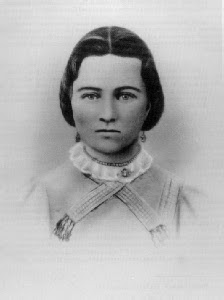 |
| Sarah Lucretia Holbrook Tolman who traveled with Zion’s Camp at the age of 2. She was the daughter of Nancy Lambson Holbrook. |
Nancy Lambson Holbrook
” I spent two or three hours with them while my
wife was getting dinner. This was on Friday and I commenced
reading that evening, but being brought up not to spend any time
on a weekday to read, I thought I must work and as my cart was
in the field where I left it the day before where I was digging
potatoes, I went to digging potatoes, but soon found I could not
content my mind at work.I returned to the house, took the Book of Mormon, and read
for a few hours but as this was so unusual a thing for me to
stop work in the daytime, my wife became alarmed and thought I
had better be at work than spending the time reading such
deception, which called my attention again to my potato digging.
I had not dug long before I wished with all my heart I knew all
there was in that book.I went out into a large place nearby
where the thistles were very large and thick. I knelt down to
pray. I no sooner closed my eyes than it seemed as though the
whole thistle plantation was in motion. I opened my eyes. I
could see nothing the matter. I closed my eyes the second time
when it seemed as if there was a whistle wind among the
thistles, yet I felt no wind. I continued my prayer for the
forgiveness of my sins and for the Lord to lead me right and
show me the truth of Mormonism. When I rose, I said I would go
to the house and read the Book of Mormon, work or no work. This
was the after-part of Saturday. I read that day and night late.On Sunday, I read again. My wife took the child in the morning
and went about 3/4 mile to my brother’s, saying she would not be
in the house and hear such nonsense. I read and prayed a number
of times that day, being all alone and marvelled much that the
thistle should be so troubled at my prayers and my wife should
be so disturbed she could not stay at home for she was always
fond of sitting down and reading evenings and Sundays.” (Source)
“The first of May [1834] we left Kirtland for New Portage,
about 50 miles, where the brethren were to meet with us for
Missouri. At this place on May 6, 1834, the [Zion’s] camp of
the Saints was organized for our journey by the Prophet Joseph
Smith. Every man gave into the treasury, the amount of means he
had for the journey except those that had families who were
directed to provide for themselves inasmuch as they had means to
do so. The company was divided into messes of ten persons each
with a captain to each ten, and over each five, ten or fifty
persons there was a captain of fifty and over each hundred, a
captain, according to the ancient order of Israel.We were led by the Prophet Joseph Smith, Jr. and pitched
our tents by the way as we traveled having the most perfect
order in our camp, having at the sound of the bugle in the
morning and evening prayers in each tent of ten men. While
everyone was to be engaged in preparing food, looking after
teams, etc., as they were organized and appointed their several
duties by the Prophet of the Lord, who was our leader….We having teams, we progressed on our journey at a rapid
state considering the bad roads in a new country, often 40 miles
per day. We generally lay by … on the Sabbath and held
meetings on the campgrounds, which was very interesting and
instructive to us.” (Source)
On the trip Nancy was one of the first to contract cholera but as Joseph recorded, ” she recovered from
it in a few days, being administered to by Brigham Young and
others for her recovery.” The Holbrook’s settled in Missouri after Zion’s Camp. As a result they were in the thick of the persecution and violence that surrounded the saints as they were driven out of Missouri. He wrote,
“My wife had very poor health during the fall and winter by
being exposed much to the inclement weather by having to remove
from place to place as our house had been burned and we were yet
left to seek a home wherever our friends could accommodate us
and for my safety but as I cannot write one hundredth part of
the suffering and destruction of this people who were in a
flourishing condition a few months before but were now
destitute. I could have commanded some $2,000.00 but now I had
only one yoke of oxen and two cows left.” (Source)
Nancy, Joseph, and their children made it safely through the trials in Missouri (though Nancy gave birth to a stillborn son) and gathered with the Saints in Nauvoo. Not long after they got to Nauvoo, which was still a swamp, Nancy got sick and died. Joseph wrote these touching words about his wife,
“Thus I had in an unexpected moment been deprived of
one of the best wives and the best of mothers. She had stood
with me in six troubles and in the seventh she did not forsake
me. She had passed through the Missouri troubles with all the
attendant evils with fortitude and forbearance. Her faith had
always been firm and unshaken in the cause of God in those last
days without a murmur or a reflection. She had firm hopes in a
glorious resurrection for which she had obeyed the gospel and
lived and spent her life for, in the most perfect understanding,
for almost twelve years… She had hoped to live
and enjoy the society of the Saints and hear the words of our
beloved Prophet Joseph Smith, in whom she had full faith. But I
am glad that she lived so that she had a good burial in the
burying grounds with the Saints, where she may rest until the
morn of the first resurrection, is my prayer in the name of
Jesus Christ. Amen.”(Source)
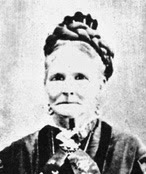 |
| Eunice Dunning Holbrook |
Eunice Dunning Holbrook
Eunice was Nancy Lambson Holbrook’s sister-in-law and was married to Joseph Holbrook’s brother Chandler. Eunice and Chandler were taught the gospel by Joseph and Nancy and joined the church not long after they did. Eunice and Chandler took their 1-year-old daughter Diana along with them as they marched with Zion’s Camp. Eunice’s experiences were very similar to that of Nancy’s and she too contracted cholera and was healed. Joseph Holbrook wrote,
” The next day my
brother Chandler and myself went out to cut some house logs but
we found ourselves too weak to chop and had to return to our
wagons entirely tired out. A brother Lynes Nantels being
present, said he lived about a mile from that place and he had
rented a stable and corn crib and that we were welcome to use
them if we liked. In the morning my brother’s wife, Eunice
Holbrook, was very sick with the cholera. We therefore thought
it best to get some place as soon as possible so we removed to
the stable and corn crib, although it was raining a perfect
shower. By the middle of the forenoon, my brother’s wife was
cramping with most violent spasms for life, but Cyrus Zaddacks and Carkis Branger took her into the house and nursed
her with the greatest attention so that in a few days she had
escaped the hands of the destroyer, but some 17 of our [Zion’s]
camp fell victims in a few days to the cholera. I moved into
the corn crib and my brother into the stable as the brethren who
had been driven from Jackson County last fall had occupied all
the houses in the county, it being new but few to be had.” (Source)
Eunice and Chandler also settled in Missouri, close to Nancy and Joseph, and suffered many of the same persecutions that they underwent. Eunice crossed the plains and she and her husband settled Filmore, Utah. One story I read said that she and her husband later ended up adopting two Indian girls who had been taken prisoner by a different tribe of Indians. The Indians were trying to sell the girls as slaves and if the settlers wouldn’t buy them they would kill them.
Jane Clark
Joseph Holbrook listed her in his account of Zion’s Camp, but nothing else is known about her or who she was.
Louisa Aurelia Curtis Houghton
Aurelia and Osmon Houghton joined Zion’s Camp in Michigan when Hyrum Smith traveled there looking for members willing to join. Radke wrote,
“The only documented case of discord within the group arose concerning the Houghtons. A spirit of conflict emerged because members
of the branch felt that the couple did not carry their full workload. Fordham remembered that,
“as som of the brethren had thoughts that bro & sister houghton had not
done their duty and we had cast reflections and hints we were astonished
at the consequences when we were informed of them by bro smith we
saw the evil felt humble and readily confessed to each other and to god
and with uplifted hands covenanted to forget and forgive all that had
passed and do so no more.” (Source)
Aurelia and Osmon settled in Missouri and later took care of Aurelia’s younger sister, Mary. Mary’s daughter, Charlotta Juline Markham Crow, wrote this about her aunt.
“Mr. Houghton and his wife had lost
their oldest child and they felt so lonely and bad that they took Mary
to live with them. Aurelia wanted
Sarah, who was two years old, but Ornan wanted Mary, who was four years
old, as while traveling she had hung to him so close he had become very
much attached to her.” (source)
Aurelia died in Nauvoo in February 1845, she was only 26-years-old.
There were two other children that also traveled with Zion’s Camp, Sarah Pulsipher who was the daughter of Zera Pulsipher and Almira Winegar who was the daughter of Samuel Winegar.
As I studied these women’s lives and their experiences I was so touched by their courage and their faith. These women wanted Zion and they were willing to sacrifice everything for it if needed.
Their examples remind me that if we want Zion to be redeemed, if we want to help build God’s kingdom, it takes courage, sacrifice and willingness to follow the prophet through thick and thin. I hope that as you study the Doctrine and Covenants in the future, specifically sections 103-105, that you will remember these women and that they also marched with Zion’s Camp.
“All victory and glory is brought to pass unto you through your diligence, faithfulness and prayers of faith.”


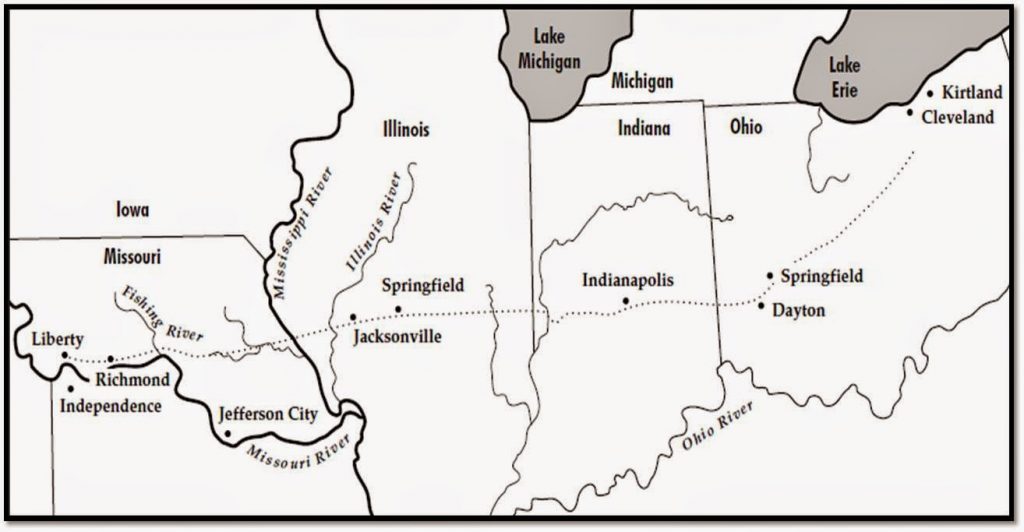






Thank you Heather for the work that went into this post. It does my heart good to learn about the experiences of women in history. I visited the Mormon Batallion Historical Site in San Diego recently and appreciated learning there about women and children who traveled with the Mormon Batallion. Check that out if you haven't already.
I'm glad you enjoyed it! I read during my research for this post about the women in the Mormon Battalion, I didn't know that there were women included! I will have to read up on that too. Thanks for the suggestion.
Thank you for writing this! My husband taught a lesson about Zion's Camp when he was in the Elder's Quorum Presidency, and the church history manual he used as a resource mentioned just the number of women who were in the camp, and I remember wondering about their stories, so this post was exciting to see! Some really interesting stories, too!
The Mormon Batallion is a really cool place. If you ever get the chance to go to San Diego it is a great family activity, and an interactive learning experience run by sister missionaries who talk about some of the amazing women who were apart of it.
Oh, I love this. Charlotte Alvord & Lyman Curtis are my 5th great-grandparents. I wish I knew more of Charlotte's motivations as well. Her mother passed away when she was ten years old, and family history notes that she was mothered by many of her sisters in the Gospel. Perhaps one of those surrogate mothers was also in the camp. I'd love to ask her some day! Thanks for shining a spotlight on these brave women, Heather.
Thanks to Dr Ekaka for the good result i got from his spell last week, My husband that was sentence 7 years in prison for something he knew nothing about, has just before released under 2 years with the help of Dr ekaka Email: ekakaspelltemple@yahoo.com i am so excited having my lovely husband back home. It still just like a dream to me that their are still powerful men like Dr Ekaka who can say something and it will come to pass.
I finally sat down to read this tonight. So many inspiring stories! Thanks for putting them all in one place. I have a special place in my heart for Zion's Camp.